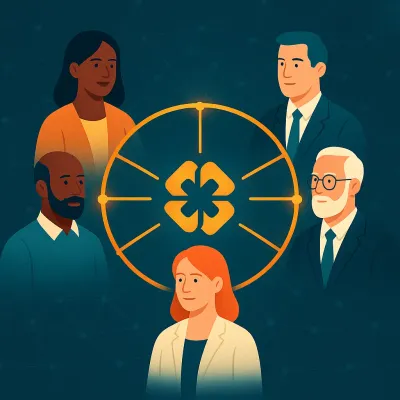In the bygone days of software development, the industry was marked by incessant delays and persistent challenges in releasing stable versions. The traditional waterfall framework, once the cornerstone of software development, became a symbol of rigidity. Organizations craving flexibility and rapid adaptability knew they had to pivot. That's where Agile stepped in.
1. What is Agile?
Before diving into the intricacies of how Agile acts as a perfect vehicle for culture change, let's first clarify what Agile is.
Agile is a project management and product development methodology that prioritizes flexibility, collaboration, and customer satisfaction. It divides projects into smaller bits, called 'iterations', allowing for regular reviews and modifications to ensure that the end product aligns with customer needs.
2. The Agile Impact on Organizational Culture
Agile, more than a mere approach to software development, has set the gold standard for how organizational culture can be effectively transformed. Here, we dissect its key components:
| Component | Description | Example |
|---|---|---|
| Intense Focus on Key Behaviors | Agile emphasizes a few essential behaviors, avoiding broad, sweeping changes that can be hard to implement. | One key behavior in Agile is "Responding to change over following a plan." This allows teams to adapt to evolving client needs. |
| The Work Itself as the Change Vehicle | Agile integrates change within daily tasks, not as an external burden. | A developer in Agile might attend daily stand-up meetings as a modification to how they start their workday. |
| Measurability | Metrics and feedback loops are integral, making every aspect of work quantifiable. | During sprints, burn-down charts track the amount of work remaining, helping teams recalibrate strategies. |
| Motivation through Transparency and Inclusion | Agile's transparent nature ensures every stakeholder feels valued and involved. | A Product Owner can see how many tasks a development team has completed in a sprint, ensuring clarity. |
| Clear Roles and Accountabilities | Everyone knows their responsibilities, streamlining processes. | In Scrum, a Scrum Master ensures the team follows Scrum principles, distinct from the Product Owner who prioritizes tasks. |
| Comprehensive Training and Skill Path | Agile provides a clear skill development approach. | Certifications like Certified Scrum Master (CSM) offer a clear path to mastering Agile methodologies. |
| Universal Buy-in | Agile mandates collaboration at all tiers, emphasizing holistic commitment. | Spotify's squads, tribes, chapters, and guild structure shows Agile principles adopted company-wide. |
| Tangible Outcomes | Clear outcomes underline Agile's efficacy. | According to a State of Agile Report, 95% of respondents practiced Agile, with 65% noting improved project visibility. |
3. Lessons from Agile's Transformational Power
Agile has transformed not just the way software gets developed, but also how work is fundamentally approached, executed, and delivered. This isn't a mere process adjustment; it's an ethos shift. By its very design, Agile is rooted in the value of "agility". To understand its transformational power, it's crucial to dissect how Agile impacts "how work gets done" and how this alignment with the agility value fuels rapid change and buy-in.
Agile Mindset: Embracing Change Over Rigid Planning
Agile champions the ability to adapt. Traditional work methods involve lengthy planning stages, where alterations can be cumbersome. In contrast, Agile welcomes evolving requirements, even late in development, so teams can easily pivot in response to feedback or changing business conditions.
Agile Process: Frequent Iterations for Continuous Improvement
Agile methodologies, like Scrum, employ time-boxed iterations (sprints) that last between one to four weeks. These sprints allow teams to prioritize tasks, execute them, and then review. This frequent cycle facilitates a quicker feedback loop, ensuring that the team continually refines and improves its processes in real-time.
Agile Teamwork: Cross-functional Collaboration
Agile dismantles silos. Instead of having specialized teams work in isolation, Agile promotes cross-functional teams comprising individuals with diverse skills. This blend ensures that the project benefits from varied expertise and viewpoints, making the outcome more holistic and innovative.
Agile Transparency: Visualizing Work with Transparent Tools
Agile tools, like Kanban boards, visualize the flow of tasks. Every team member can see what's being worked on, who's handling what, and what's coming next. Such transparency ensures that the entire team aligns with the project's status and priorities, fostering a shared understanding and accountability.
Agile Focus: Customer Feedback at the Core
In Agile, the end-user or customer is integral. Regular reviews involve showcasing increments to stakeholders, ensuring that the product or solution remains aligned with user needs. By keeping the customer at the center, Agile ensures that work processes consistently deliver value.
Agile Accountabilty: Shared Leadership and Empowerment
Agile redistributes leadership. Instead of a single project manager dictating tasks, the responsibility is dispersed. Teams self-organize, decide how to meet objectives, and tackle challenges. This empowerment accelerates decision-making and cultivates a sense of ownership among members.
Agile Alignment: Linked with Organizational Goals
By breaking down tasks into manageable chunks and prioritizing them based on value delivery, Agile ensures that teams are always working on tasks that align most closely with organizational objectives. This direct alignment ensures that every bit of effort contributes to broader organizational goals, maximizing efficiency and effectiveness.
These aspects illustrate how Agile reforms the work process. Each facet reinforces agility, ensuring that processes aren't just new but are better aligned with contemporary business needs. And when every team member observes firsthand the benefits of these aligned processes, buy-in becomes organic. The transformation isn't thrust upon them; they live it, appreciate its merits, and become its advocates. This lived experience accelerates the adoption rate, making the shift to Agile not just swift but also sustainable.
4. Why Agile Can Sometimes Stumble
Agile, with its mature and widely-accepted methodology, has proven results in fostering culture transformation. Yet, it too can falter. The reasons for such stumbles highlight essential components crucial for any culture transformation initiative. Understanding why Agile might falter can guide organizations to safeguard their transformative journeys, ensuring that all critical pieces align for success.
- Lack of Leadership Commitment: Top executives play a crucial role in championing change. When senior leadership remains indifferent or half-hearted about Agile adoption, the transformation stays superficial. Employees invariably follow their leaders' cues, and the lack of genuine commitment from above makes grassroots acceptance challenging.
- Ambiguity in Transformation Goals: Clarity is the beacon guiding Agile transformations. Teams need to understand not just the 'what' but also the 'why'. Without a lucid comprehension of the desired behavioral changes and the overarching goals, teams risk becoming rudderless, leading to inconsistent application and missed objectives.
- Accountability Gaps: Agile thrives on individual and team ownership. If teams aren't held accountable or if they don't truly own their tasks and outcomes, the transformative potential of Agile becomes compromised. Without clear accountabilities, even the best-laid Agile plans can go astray.
- Insufficient Training and Upskilling: Adopting Agile often demands new skills and a paradigm shift in thinking. If teams aren't adequately trained or upskilled to meet these demands, they'll struggle to keep pace. This insufficiency can lead to frustrations, reversion to old habits, and a diluted Agile culture.
- Misaligned Values and Mission: For Agile to truly take root, its values must be in harmony with the broader organizational ethos. If there's a disconnect, or if Agile principles seem at odds with the company's mission or existing values, conflicts can arise. Such misalignment not only hampers Agile adoption but can also erode trust.
The stumbles of Agile underscore the intricacies of culture transformation. It requires synchronized alignment of values, processes, people, and patience. The missteps, rather than deterring, should inform and guide. They stand testament to the idea that for a successful transformation, every piece of the puzzle needs to be attentively placed.
Conclusion: A Page from Agile's Playbook
Agile demonstrates that genuine culture change goes beyond mere strategies or communication plans. The crux lies in altering the work processes themselves. When culture and work processes converge, as seen in Agile, the impact on an organization is direct and substantial.
Key lessons from Agile's success are:
- Work processes are fundamental to culture change.
- Accountability and clarity are prerequisites for transformation.
- The method of work execution can itself be a catalyst for change.
As organizations aim for culture transformation, Agile's framework offers a pragmatic approach: Don't just define new behaviors, modify the foundational processes. It's not merely about 'what' changes, but 'how' the change is enacted.










